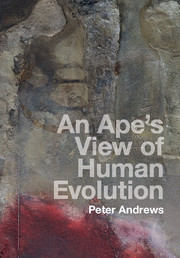Book contents
- Frontmatter
- Contents
- Preface
- 1 How can we recognize common ancestors?
- Part I Apes: their morphology and behaviour
- PART II Environments and palaeoenvironments
- Part III Review of fossil apes
- 7 The view from the early Miocene
- 8 The environment in the early Miocene
- 9 The view from the middle Miocene
- 10 Specialized apes from the middle Miocene
- 11 The environment during the middle Miocene
- 12 A second view from Europe
- 13 The environment in Europe
- 14 Late Miocene to Pleistocene apes
- 15 Apes, hominins and environment in the late Miocene
- Part IV Last common ancestor
- References and further reading
- Index
- References
9 - The view from the middle Miocene
from Part III - Review of fossil apes
Published online by Cambridge University Press: 05 January 2016
- Frontmatter
- Contents
- Preface
- 1 How can we recognize common ancestors?
- Part I Apes: their morphology and behaviour
- PART II Environments and palaeoenvironments
- Part III Review of fossil apes
- 7 The view from the early Miocene
- 8 The environment in the early Miocene
- 9 The view from the middle Miocene
- 10 Specialized apes from the middle Miocene
- 11 The environment during the middle Miocene
- 12 A second view from Europe
- 13 The environment in Europe
- 14 Late Miocene to Pleistocene apes
- 15 Apes, hominins and environment in the late Miocene
- Part IV Last common ancestor
- References and further reading
- Index
- References
Summary
The proconsulids described in the previous chapter form a coherent group that had a limited geographical distribution in eastern Africa. They were succeeded by a number of genera and species with a greater range across East Africa, and for the first time apes are known outside Africa. The African apes are grouped in the Afropithecinae (Table 4.2), but none have yet received the monographic descriptions available for Proconsul. For this reason, full descriptions cannot be provided here, and it is more convenient to compare their morphologies with those present in Proconsul. The earliest apes found in Eurasia are similarly grouped with the afropithecines, mainly on the basis of shared primitive characters, and they are described together here for convenience.
African apes
The African afropithecines are represented by Afropithecus turkanensis, which gives its name to the subfamily and is represented by single skull and fragments of jaws and teeth. There is little information as to its context. More information is available from two partial skeletons: Equatorius africanus from Kipsaramon in the Tugen Hills and Maboko Island, and Nacholapithecus kerioi from Nachola in northern Kenya. Both have partial skeletons and both are from deposits approximately 15 million years old. The former species is now grouped with a specimen from Maboko Island that has had a rather chequered history since its discovery in 1948.
Wilfred Le Gros Clark and Louis Leakey attributed a single specimen of fossil ape from Kenya to Sivapithecus africanus because of its supposed similarities with the Indian species of Sivapithecus (Figure 9.1). It was recorded as coming from Rusinga Island and was thus coeval with Proconsul. However, it is also similar to the species of the middle Miocene genus Kenyapithecus from western Kenya, and in 1961 Louis Leakey renamed it Kenyapithecus africanus along with a number of other specimens from Rusinga, which together he was proposing as an early Miocene human ancestor. Its differences in morphology and preservation from the large sample of fossil apes from Rusinga remained a source of puzzlement for many years, and in 1978, Theya Molleson and I decided to test the provenance of the specimen.
- Type
- Chapter
- Information
- An Ape's View of Human Evolution , pp. 150 - 160Publisher: Cambridge University PressPrint publication year: 2016



